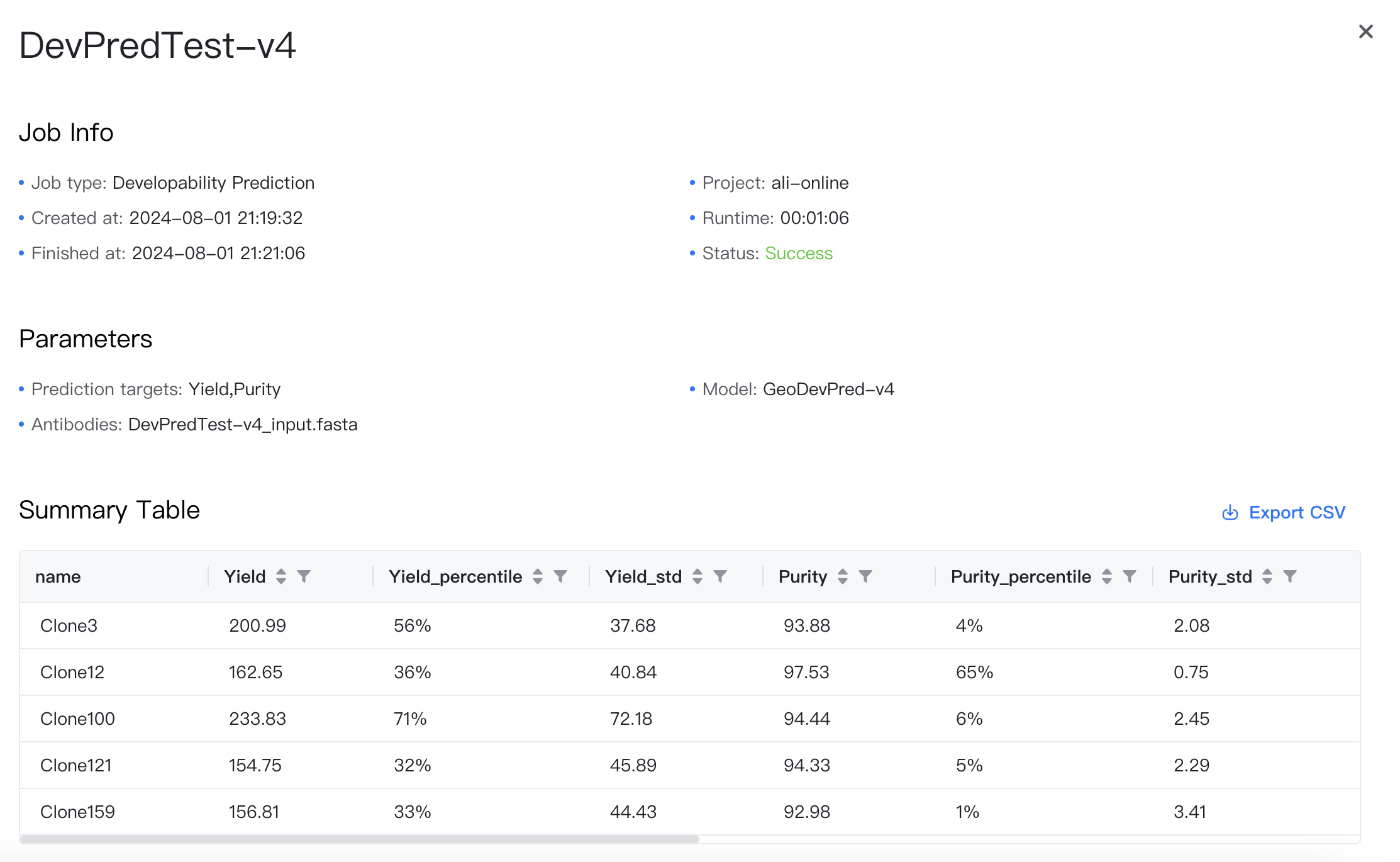Antibody Developability Prediction¶
Antibody developability prediction estimates key developability properties, such as expression yield, thermostability, aggregation, etc., of an antibody given its sequence. It facilitates developability assessment and optimization early in the antibody design process.
This model has been integrated into the "Antibody Optimization" job
When you create an Antibody Optimization job, the expression yield and purity of the antibody and its mutants will be automatically calculated.
Features¶
- Comprehensive prediction: Predicts multiple critical developability properties including expression yield, thermostability, aggregation, etc.
- State-of-the-art algorithm: Powered by advanced deep learning techniques including large language models and geometric deep learning. Enables joint sequence- and structure-based prediction which is more robust.
- Convenient usage: You only need to input the antibody sequence.
Inputs¶
To submit an Antibody Developability Prediction job, open the Project Editor and click "New Job" button on the left sidebar. Then click "Developability Prediction" under the "Antibody Design" group to open the job submission page.
-
Antibody: Input antibody in FASTA format. You can either enter the sequence directly or upload a FASTA file by clicking "
". The antibody should contain both heavy and light chains labeled as
_Hand_L. -
Job Name: Name of the job. Must be unique within the project.

Models & Parameters¶
You can leverage multiple proprietary models for this job: GeoDevPred-v2, GeoDevPred-v3 (default) or GeoDevPred-v4.
For GeoDevPred-v2 model, you need to specify the Prediction targets, i.e. the developability properties to predict. Select one or multiple from below (defaults to all):
-
HEK Titer (mg/L)
Expression yield in human embryonic kidney (HEK) 293 cells. Higher is better.
-
Fab Tm by DSF (°C)
Thermostability of the Fab (antigen-binding fragment), observed using differential scanning fluorimetry (DSF). Higher is better.
-
HIC Retention Time (min)
Antibodies with more hydrophobic characteristics have a longer hydrophobic interaction chromatography (HIC) retention time. Lower is better.
-
Accelerated Stability SEC Slope
Stability of the antibody, measured by size-exclusion chromatography (SEC) slope under accelerated stress conditions. Lower is better.
-
AC-SINS ∆λmax (nm)
The Affinity-capture Self-interaction Nanoparticle Spectroscopy (AC-SINS) assay tests how likely an antibody is to self-interact. It uses gold nanoparticles that are coated with anti-Fc antibodies. If antibodies captured by the gold beads subsequently attract one another, it leads to longer absorption wavelengths that can be detected by spectroscopy. Lower is better.
-
Viscosity at 150 mg/mL (cP)
Thickness or resistance to flow of an antibody solution at a high concentration (150 mg/mL). Lower viscosity is generally better for manufacturing and for the end-user.
-
SMAC Retention Time (min)
The longer the Solvent-Modified Affinity Chromatography (SMAC) retention time, the lower their colloidal stability. Lower is better.
GeoDevPred-v3 and GeoDevPred-v4 models can predict the expression yield and purity of monoclonal antibodies.
-
Yield (mg/L)
Expression yield in Chinese Hamster Ovary (CHO) cells. Higher is better.
-
Purity (%)
Purity of the antibody monomer determined by SEC-HPLC. Range: 0-100%. Higher is better.
Results¶
The results are summarized in a CSV file, which can be downloaded by clicking the "" button.

It contains the following columns ({property} can be replaced with each developabiliy defined previously):
- name: Name of the input antibody.
- VH_sequence: Sequence of the heavy chain variable domain of the input antibody.
- VL_sequence: Sequence of the light chain variable domain of the input antibody.
- {property}: Predicted value of the target property.
- {property}_std: Standard deviation of the predicted value. The value is highlighted in red when the uncertainty is too high to be trusted. Only GeoDevPred-v3 and newer models will output this column.
- {property}_percentile: Predicted value of the target property. Higher value indicates better developability regarding the specific property.